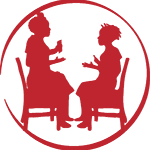Select a Combination of Lead and Supportive Channels
Once you know the communication channels that your intended audience uses and the channels available in your city, it’s time to narrow down the channels and select the ones that you will use in your SBCC program.
The lead channel is the main channel used in your intervention. Most of the information is passed through the lead channel, which is likely to have the greatest reach.
The supporting channels are other channels of communication that are used in the intervention. The aim of supporting channels is to reinforce messages by increasing the likelihood that audiences will hear them more often and through a variety of channels.
For example, an intervention’s lead communication channel may be television. The intervention might use television to reach the whole country with advertisements and a serial drama. Supporting channels may include:
Small group discussions in the community where people watch an episode of the serial drama and then discuss it with a facilitator (IPC).
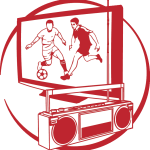 Posters and billboards that depict characters from the serial drama with key messages relating the the storyline and the health issue being addressed (mass media).
Posters and billboards that depict characters from the serial drama with key messages relating the the storyline and the health issue being addressed (mass media).
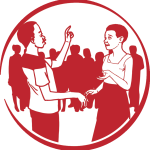 Participatory theater in the community where performers represent the characters from the serial drama and enact scenes relating the the themes discussed by the drama (community-based approach).
Participatory theater in the community where performers represent the characters from the serial drama and enact scenes relating the the themes discussed by the drama (community-based approach).
 A Facebook page about the serial drama where key messages and related articles are posted regularly (social media).
A Facebook page about the serial drama where key messages and related articles are posted regularly (social media).
Think about your SBCC program and how you would answer these questions:
- Which channels are available to you based on your program budget and timeline?
- Which channels can facilitate the type of communication needed? (e.g., one-way delivery of information or more interactive discussion, or information delivered publicly or privately.)
- Which channels are best for reaching your intended audience? (e.g., is radio preferred or is it perceived as an unreliable source of information?)
- Which channels are already most accepted by your audience for the types of information or messages you are trying to convey?
- Which channel will reach the largest proportion of the intended audience?
Definition
A channel is effective if it gets the attention of your intended audience and inspires behavior change.
A channel is efficient if it is reaching the largest number of your intended audience for the amount of money spent on that channel.
To get the best value for your budget, select channels that are going to be the most effective and efficient for reaching your intended audience. See Figure 12: Choosing Communication Channels for considerations when choosing communication channels. Worksheet #11: Selecting Communication Channels will help you apply this to your program.
Choosing Communication Channels
| Considerations | Appropriate Channels / Approaches |
|---|---|
| Complexity of the Challenge |
|
| Sensitivity of the Challenge |
|
| Effectiveness of Approach to Address Challenge |
|
| Literacy |
|
| Desired Reach |
|
| Innovation |
|
| Cost |
|
Worksheet #11
Selecting Communication Channels
Worksheet #11 Example
Selecting Communication Channels: Zanbe
Reminder!
Creating Surround Sound and Message Reinforcement
Creating “surround sound”—using multiple channels to reach your audience with consistent messaging—is an important principle in SBCC programming. When the intended audience receives messages in fresh and different ways from different channels the message is more likely to be heard.
When planning your SBCC intervention, make sure that the same messages are passed through different channels. In this way, the messages reinforce each other and they are more likely to lead to behavior change.
This means that messages Awa hears on the radio are the same as or complementary to the messages that are delivered by peer educators and displayed on posters and fliers. Make sure your messages have common branding (images, name, logo and slogan) as this will help the audience make the associations between messages and reinforce them.
To get a picture of “surround sound,” think of Awa during a typical week in her life and the various channels through which she receives consistent messaging as part of the Let’s Talk About It! program:
![Q-5 Waking up with radio_v3[2]](https://sbccimplementationkits.org/urban-youth/wp-content/uploads/sites/9/2015/09/Q-5-Waking-up-with-radio_v32-300x295.jpg) Awa wakes up early on Monday to hear her favorite radio DJ chatting about how to have a healthy relationship and he mentions that the Bright Star City Clinics are places where youth-friendly providers are available to counsel young people on contraception.
Awa wakes up early on Monday to hear her favorite radio DJ chatting about how to have a healthy relationship and he mentions that the Bright Star City Clinics are places where youth-friendly providers are available to counsel young people on contraception.
As she listens to the radio, she hears the promotional spot reminding her to tune in at 4:00 p.m. every Wednesday for the latest episode of “Zanbe Love,” the serial drama about the love lives of urban adolescents that is funded by the Lets Talk About It! program. Once her mom is awake, she turns off Awa’s radio program to listen to the news.
![Q-6_Posters on way to school_V3[1]](https://sbccimplementationkits.org/urban-youth/wp-content/uploads/sites/9/2015/09/Q-6_Posters-on-way-to-school_V31-300x273.jpg) As Awa walks to school, her journey takes her through small trading centers with small shops. She often sees a poster in the window of her favorite clothes store with a picture of a young girl on her way to university and a tagline that says she avoided an unintended pregnancy by using contraceptives and is pursuing her dreams. She continues walking along the main road as mini-busses pass by, several with posters of the different characters in “Zanbe Love” on the side of their vans.
As Awa walks to school, her journey takes her through small trading centers with small shops. She often sees a poster in the window of her favorite clothes store with a picture of a young girl on her way to university and a tagline that says she avoided an unintended pregnancy by using contraceptives and is pursuing her dreams. She continues walking along the main road as mini-busses pass by, several with posters of the different characters in “Zanbe Love” on the side of their vans.
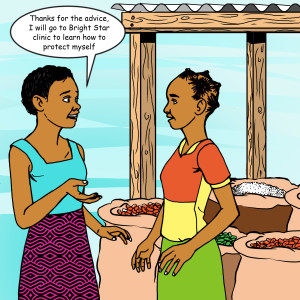 After school, Awa often looks for her friend Léonore, who sells grains and spices in the city market. On Wednesdays, Léonore usually talks to her about what she has learned at her peer education training. This week, she shares what she learned about how to have a healthy relationship and tells Awa about the risks of having unprotected sex. She answers Awa’s questions as best she can, but also suggests that she go to a Bright Star City Clinic to get accurate information from a health care provider.
After school, Awa often looks for her friend Léonore, who sells grains and spices in the city market. On Wednesdays, Léonore usually talks to her about what she has learned at her peer education training. This week, she shares what she learned about how to have a healthy relationship and tells Awa about the risks of having unprotected sex. She answers Awa’s questions as best she can, but also suggests that she go to a Bright Star City Clinic to get accurate information from a health care provider.
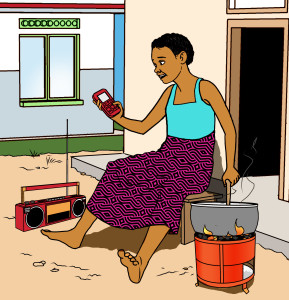 On Wednesday, Awa listens for 30 minutes to “Zanbe Love.” This week, she finds out that her favorite character, Maria, may have to drop out of school because her parents can’t pay the fees. An older man Maria knows hints that he could give her the school fees if they have a sexual relationship, but she remains strong and refuses. This makes Awa think about the boys that are starting to suggest things to her when her mother doesn’t have money for her school fees. She texts a question she has to the Zanbe Love number, since they always respond quickly and the information is private.
On Wednesday, Awa listens for 30 minutes to “Zanbe Love.” This week, she finds out that her favorite character, Maria, may have to drop out of school because her parents can’t pay the fees. An older man Maria knows hints that he could give her the school fees if they have a sexual relationship, but she remains strong and refuses. This makes Awa think about the boys that are starting to suggest things to her when her mother doesn’t have money for her school fees. She texts a question she has to the Zanbe Love number, since they always respond quickly and the information is private.
![Q-9_Walking by Bright Star City Clinic neon sign_V2[4]](https://sbccimplementationkits.org/urban-youth/wp-content/uploads/sites/9/2015/09/Q-9_Walking-by-Bright-Star-City-Clinic-neon-sign_V24-300x300.jpg) On Fridays, Awa often works in the Central Market selling clothes, and, after closing up her stall for the day at sundown, she heads out to meet some friends at a café and notices the neon star sign for Bright Star City Clinic. Though most businesses are closed, this one seems to still be open...
On Fridays, Awa often works in the Central Market selling clothes, and, after closing up her stall for the day at sundown, she heads out to meet some friends at a café and notices the neon star sign for Bright Star City Clinic. Though most businesses are closed, this one seems to still be open...
As you can see from Awa’s week, she was exposed to positive messages about contraception and sexual health through different channels:
Her favorite radio program discusses SRH and reminds listeners of the Bright Star Clinics and their services.
Radio spots remind her of the Zanbe Love serial drama, where SRH is discussed. Going to school she sees posters and billboards on busses about SRH and Zanbe Love.
Her friend is becoming a peer educator and shares information about SRH with Awa.
Ensuring that your SBCC programs use similar messages across different channels will increase the likelihood that your intended audience will hear them, think about them and eventually take action!


